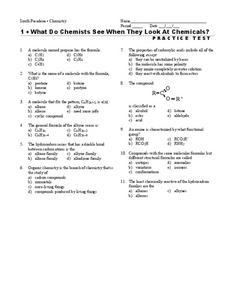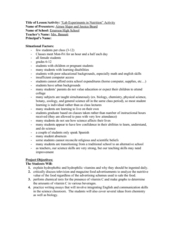Curated OER
Finding the Ages of Rocks and Fossils
Students practice dating fossils. They learn the concept of "deep time"--that earth was formed billions of years ago. They experience excellent hand-outs and virtual age tutorial links.
Curated OER
Liquids Have Differnt Viscosities
Students explore visosity of matter. They run tests of various liquid substances to observe and compare rates of flow of different substances. In addition, they relate viscosity to distance travelled by sample substances.
Curated OER
Chapter Review Topics for Exam 2
In this chemistry chapter review learning exercise, students examine their knowledge of equilibrium, Brønsted acid, and pH value as they respond to 25 short answer questions.
Curated OER
Sweet Science: How Sugar Molecules are Manipulated in Candy Making
Young scholars investigate how heat affect sugar solutions. In this science lesson, students compare the sweetness of different types of sugars. They research the development of sugar and create a timeline.
Curated OER
The Chemistry of Water / Industrial Waste at My High School
Students gain factual knowledge of the nature of industrial waste at on their school site. They gain process knowledge of the laboratory techniques and collection procedures for wastewater samples.
Curated OER
Is Your Water Clean?
Students compare water quality of different sources. They test water samples for odor, phosphates, pH, bacteria, and dissolved solids. they fill out a data table and answer questions about their findings.
Curated OER
Time Signifiers - Past or Present Perfect?
Pupils refine their usage of past simple or present perfect. After a lecture/demo, students work in pairs and utilize a worksheet imbedded in this plan to help them gain practice with time signifiers.
Curated OER
E3 Project
Students investigate excited electrons. In this chemistry lesson plan, students will go through a series of activities designed to help them understand how excited electrons emit different colors of light.
Virginia Department of Education
Molecular Model Building
During this hands-on activity, young chemists build molecular models based on the Lewis dot structure before studying valence shell electron pair repulsion theory.
Curated OER
Food & Science - How Healthy is Your Diet?
Learners experiment with various foods to determine fat and starch content. They rub jam, peanut butter, bananas, and other foods in a small circle on a piece of paper, and observe the results. If there is a high fat content in the...
Curated OER
The Dose makes the Poison
Learners investigate the effect of a chemical (they choose) on the germination of seeds. They calculate % chemical concentrations in water, form a hypothesis, and discuss the ethics of using animals in biomedical research.
Curated OER
Acids and Bases
In this acids and bases worksheet, young scholars review the characteristics of acids and bases, pK values, factors that change the rate of reactions, and catalysts. This worksheet has 17 multiple choice questions.
Curated OER
What do Chemists See When they Look at Chemicals?
In this chemicals worksheet, high schoolers answer 15 multiple choice questions about chemicals, compounds, inorganic and organic molecules.
Curated OER
Sour and Bitter: Acids and Bases
Tenth graders distinguish between acids and bases. In this pH instructional activity, 10th graders view a PowerPoint and discuss the characteristics of an acid and a base. They investigate natural substances to determine the pH level of...
It's About Time
Elements and Compounds
Young scientists use electrolysis to separate water into its elements before experimenting with fire to learn about their properties. A helpful resource provides a reading passage and analysis questions.
Curated OER
# 14 Experimenting with Copper (II) Solutions
Students determine that the relative concentration of copper ions in water can be determined by a color comparison. They make a copper (II) sulfate solution of a given concentration. Students dilute their initial solutions until their...
Curated OER
Lab Experiments in Nutrition Activity
Which vitamins should be ingested daily for maximum nutrition? Learners with ispecial needs or those who are pregnant focused on television and magazines advertisements that are used to sell food products. They conduct experiments and...
University of Georgia
Antacid and Uncle Heartburn
Household materials can be used for more than cleaning! In this collaborative experiment, emerging chemists use products such as vinegar and liquid antacid to explore chemical reactions that commonly occur in the human body.
University of Georgia
Splat!
What does viscosity have to do with splatter? An activity shows that the viscosity of a substance is inversely proportional to the distance of its splatter. Learners conduct the experiment by collecting data, graphing, and analyzing the...
University of Southern California
Mastering Microbes
Small but mighty! Learners explore the role of microbes in a healthy ecosystem. An engaging lesson asks pupils to design an aquaponics system that demonstrates that healthy microbes are necessary to maintain the ecosystem.
Curated OER
Activity #7 Special Properties: A Discussion
Students identify special properties of matter (absorbency, hardness, brittleness, malleability, and elasticity). They define the term matter. Pupils investigate some of the special properties of matter to aid in classifying matter.
Curated OER
Behavior and Properties of Gases
Students convert Celsius to Kelvin temperature. Students conduct three lab experiments, gas law simulations using Internet applets, lectures and demonstrations. The Laws included are Boyle's, Charles, Combined Gas, Ideal Gas, and Gram's...
Curated OER
Periodic Table
In this periodic table worksheet, students characterize elements according to their group in the periodic table. This worksheet has 26 matching and 13 multiple choice questions.
Curated OER
Periodic Table
In this elements worksheet, students review the characteristics of elements and the periodic table. This worksheet has 2 different versions, one with 20 multiple choice questions and answers and the other has 17 multiple choice questions...

























